Live from Rio: ESPN’s IBC Facility Brings Nations Together; VER Plays Key Role in Making it Happen
Viewers in the U.S. may not know ESPN as the home of Olympic sports but viewers of ESPN Brazil, ESPN Argentina, ESPN Deportes, and ESPN Caribbean do and, as a result, the worldwide leader in sports once has more reasons than ever to have a big presence at the 2016 Rio Olympics International Broadcasting Center. “A lot more people came out from the networks and we are all in one area, whereas in London Brazil and Deportes were separated and Argentina was in the IBC,” says Claude Phipps, ESPN, senior remote operations specialist. “But here everyone is in one place and there is more sharing content and facilities. It’s a big step up.”
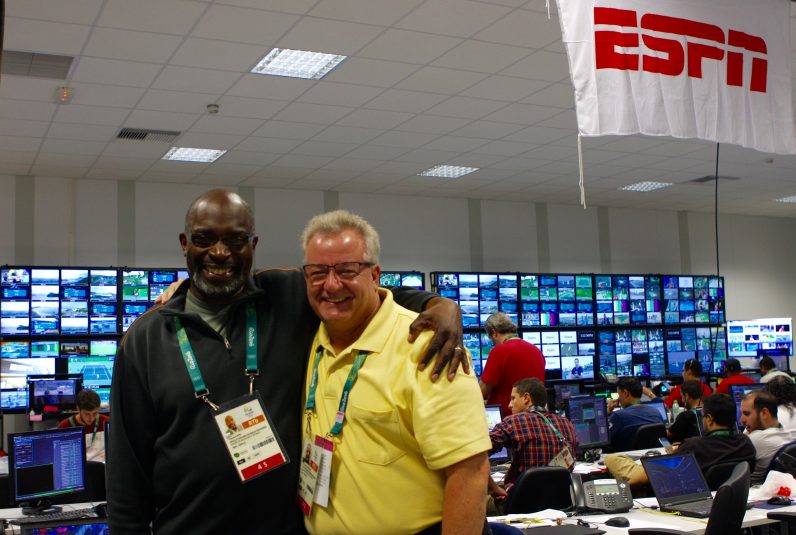
ESPN’s Claude Phipps (left) and Henry Rousseau inside ESPN’s content production area inside the Rio Olympics IBC.
Television coverage includes at least two dedicated networks in each region with 15+ hours of daily content per network, with simulcasts on ESPN Play and WatchESPN (Brazil). Live event coverage is being complemented by studio programming produced across the Rio region.
ESPN Brazil, for example, is covering all major events, including Olympic soccer and competitions featuring the Brazilian teams and athletes and ESPN Argentina is doing the same for Argentinian fans. And ESPN and ESPN2 in Spanish-speaking Latin America will present more than 15 hours of continuous daily coverage per network. ESPN will focus on the most popular Olympic events and athletes while ESPN2 will cover events with the most local relevancy. ESPN3 (Mexico and Central America only) will televise additional events of interest. Lastly, in the Caribbean, ESPN Caribbean will present more than 200 hours of coverage tailored and localized to Caribbean storylines and competitions and with both English and Spanish commentary. For a complete photo gallery of pictures from the ESPN IBC facility click here.
“I have some really good partners from ESPN Brazil and ESPN Argentina that are technical leads in their own right,” adds Phipps. “So we tried to build this together and then they have taken on the intricacies of their group. So technically we have something that works for everyone.”
“Everyone” includes nearly 500 people who are working out of the Olympic IBC as well as studio locations at the nearby Origami Building as well as in Rio de Janeiro along the famous Copacabana Beach.
“It’s amazing because we have very complex organizations here under one roof and with different ideas about how the operation should work but everyone is working together as a team,” says Henry Rousseau, ESPN, senior operations manager. “We have different languages and different workflows but we have been able to accommodate each group’s workflow and integrate them into the operation.”
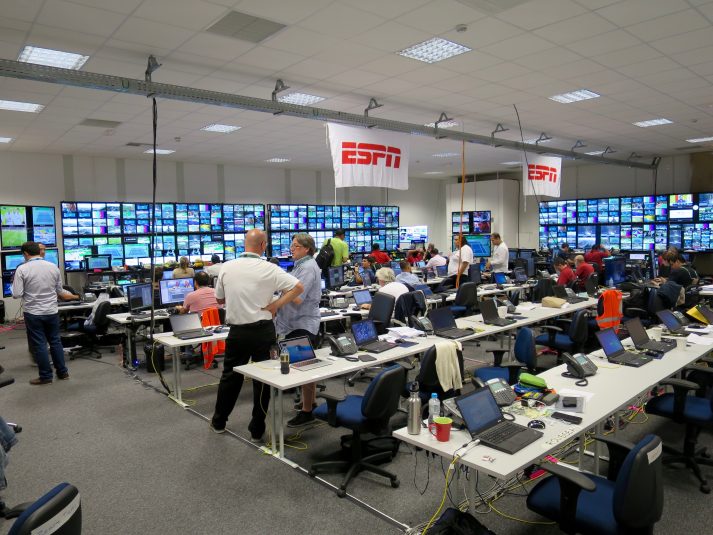
The ESPN content production area for the Rio Olympics is a virtual United Nations of content creation.
Production services and technology provider VER was tasked with the technical integration and the ESPN major event team, the various ESPN networks on site, and VER all worked together to define the technologies and workflows in use.
“We accomplished what we needed and VER was a great partner and we have a technical infrastructure and workflows so that all entities can interact and share content in a productive manner,” says Phipps.
Phipps says each one of ESPN’s large event efforts build upon the previous ones.
“At the World Cup in Brazil we had media managers and network control staffers and here we have extended that concept so you see them working together so they can switch to whatever feed they need for their own network,” says Phipps. Each network also has their own server but there is also a common server so that the networks can share clips and content.”
Adds Rousseu: “It boils down to workflow. During the first event everyone was ingesting that event but now everyone realizes how to use the shared server space and resources.”
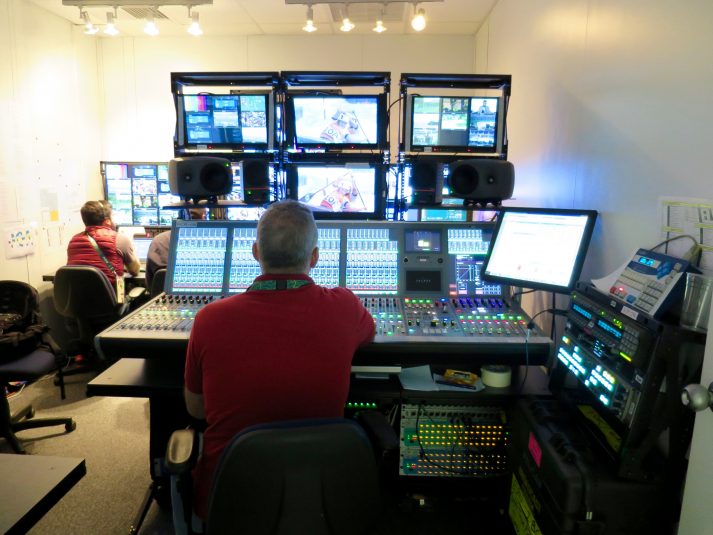
ESPN Brazil’s control room includes a Calrec audio console and Grass Valley Karrera production switcher.
Each network has their own control room featuring a Grass Valley Karrera production switcher and also a portion of a shared newsroom/content production area where they can monitor any of the incoming feeds (each network has their own dedicated portion of a massive monitor wall) that are coming in via 102 fibers that carry the OBS event audio and video signals as well as unilateral camera feeds. All of those feeds are then made available to the various production teams via nine EVS XT3 servers (with 24 channels of ingest and the rest dedicated to IP Directors and playout) and a 120 TB Harmonic Media Grid shared storage system.
“Content comes into the Harmonic near-line storage at 10 Gbps and out to the editors in the content production area at 1 Gbps so that the staff can make clips and then edit on their laptop,” says Robert “Bruno” Brunelle, VER, national director of engineering. “And the shared folder is available to everyone. And the beauty is the Harmonic transfer is fast so the user can grab a clip and there is no delay for the transfer.”
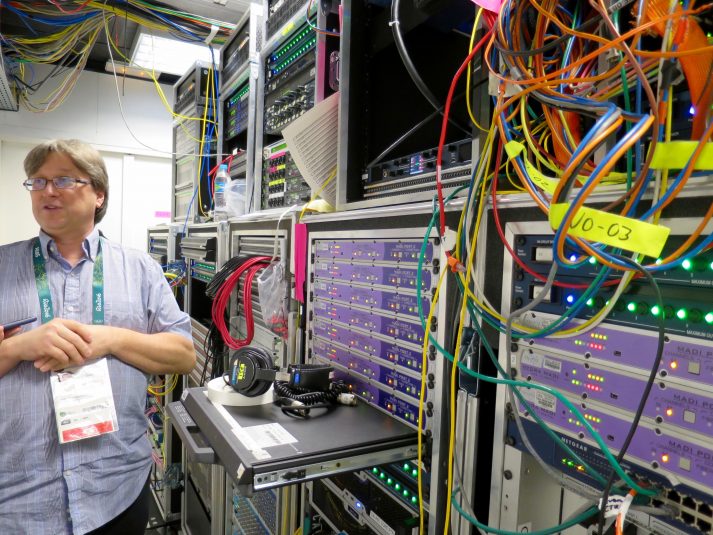
VER’s Robert “Bruno” Brunelle inside the ESPN Olympics machine room.
The control rooms, transmission area, and content production area is tied to a machine room that includes Ericsson encoders for ASI transmission and Nimbra encoders for J2K transmission, an Evertz EQX router, the nine EVS XT3 servers, and the Harmonic Media Grid and Content Grid storage system with 120 TB of near-line storage.
The audio portion of the engine room includes an RTS Adam intercom rack with 500 cross points, and Evertz EQX router, and processing for five Calrec audio consoles and routing that allows for any audio source to be called up on any audio console.
“We also are using Focusrite’s RedNet Ethernet-networked audio interface boxes to move audio back and forth with the studios with a latency to the Copacabana studios of only 3.2 milliseconds of delay so it is almost instantaneous,” adds Brunelle.
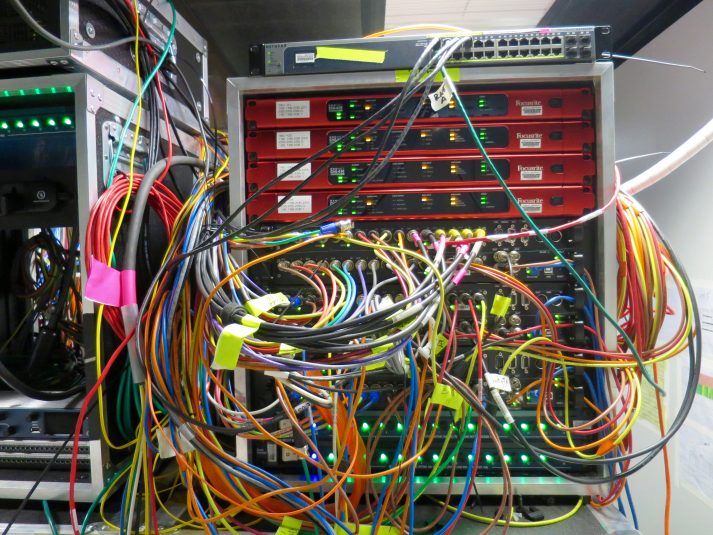
Focusrite RedNet Ethernet audio boxes are making a difference when it comes to handling audio signals between ESPN’s IBC operations and remote studios.
Full flexibility is one of the keys to the facility operations as control rooms can access any audio and video signal they need. In addition, the networks also help each other out so that, for example, if Brazil needs five ingest channels they can have access to any unused channels from the other networks. Other technical facilities include three voice over rooms and an interview room where commentary and other audio work can be completed, providing even more flexibility.
ESPN is also using the Dejero LIVE+ Multipoint video network for the Olympics.
“Dejero created Wifi hotspots here and in Copacabana that we can use and that helps us save a ton of money,” says Phipps.
One technical innovation that has helped made the use of Dejero more comprehensive is the use of an app called Unity that allows for the production team in the field to use their cellphones to receive and transmit IFB and communications with the production team.
“With Dejero you don’t have the infrastructure to connect with the IFB so you need to use cellular,” adds Phipps. “So we have taken the concept of using Dejero we did for the Pan Am games and have multiplied it by five.”

Robert Brunelle says the ESPN network teams were able to begin broadcasting sooner than expected as they quickly adjusted to new workflows.
Brunelle says installation began on July 19 and the original plan was to handover the facilities to the networks on July 30 and then have everyone spend the first couple of days learning the workflows.
“But everyone came out running and by the next day all five control rooms were transmitting,” he says.
One of the interesting cultural features of the ESPN operation is not only that there is a mix of Portugese, English, and Spanish being spoken but also that, historically, the competitive spirit between Brazilian and Argentinians can often resemble that found between Boston Red Sox and New York Yankee fan. And there is definitely a feeling of nationalism running through the ESPN facility, especially when Argentina President Mauricio Macri stopped by in the opening days of the games.
“The ESPN Argentina team was really moved that he came to see them and there is more of a national pride here, especially because we are in South America,” says Rousseu. “There is a lot of passion.”

